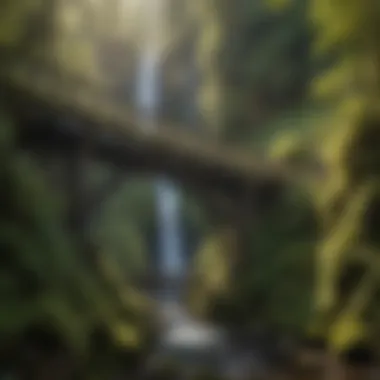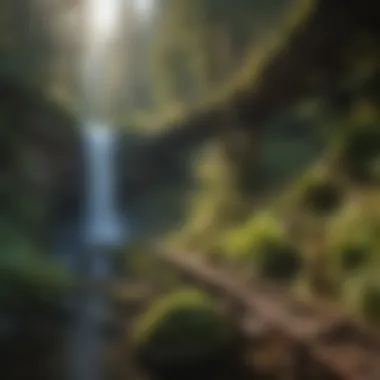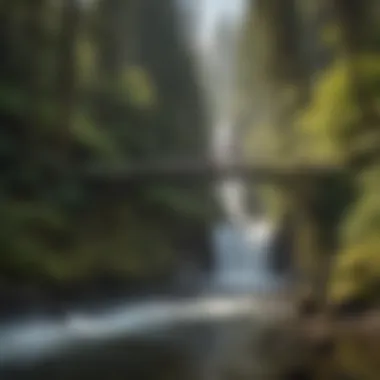Exploring Oregon's Waterfall Bridges: History and Ecology


Intro
Oregon is renowned for its rich natural beauty, and the waterfall bridges do not merely complement the landscape, they add a distinct character to it. These structures epitomize engineering ingenuity harmonized with nature, creating a visual and ecological symbiosis that is captivating. This guide delves into the myriad features of these waterfall bridges, exploring their historical context, engineering achievements, ecological implications, and the cultural narratives they inspire.
The interplay between construction and the natural world is not just aesthetic; it has real environmental consequences. Understanding these bridges requires an appreciation of the woodland ecosystems they inhabit, the sustainable practices that guide their conservation, and the stewardship techniques vital for maintaining their integrity amidst changing environments. The following sections will unpack these dimensions in detail, offering a thorough exploration of both the bridges and the ecosystems they are part of.
Prolusion to Oregon's Waterfall Bridges
Oregon is known for its breathtaking natural beauty, and the waterfall bridges are a significant part of this landscape. These structures not only connect scenic routes but also enhance the natural experience for visitors. Understanding the importance of waterfall bridges is essential for appreciating their role in eco-tourism and conservation efforts in the region. This section lays the groundwork for examining their architectural significance and ecological implications.
Defining Waterfall Bridges
Waterfall bridges are structures built over or around waterfalls, allowing for pedestrian or vehicular access while preserving the natural environment. They are designed to blend seamlessly with the surroundings, providing scenic views and enhancing the visitor experience. In Oregon, these bridges often feature unique architectural styles that reflect the local heritage and landscape.
These bridges serve both functional and aesthetic purposes. They allow easier movement for hikers and tourists while promoting the appreciation of Oregon's natural wonders. The strategic placement of these bridges often highlights the majesty of the waterfalls they span, making them an essential part of hiking trails and parks.
Historical Overview
The development of waterfall bridges in Oregon can be traced back to the early 20th century. As tourism began to grow, there was a need for infrastructure to accommodate visitors to the state's natural attractions. The first significant waterfall bridges were constructed during this period, fueled by the popularity of the scenic Columbia River Gorge region.
These early constructions displayed a mix of artistry and engineering prowess, showcasing local materials and designs. Over the years, waterfalls like Multnomah Falls and Bridal Veil Falls gained attention, and the bridges built nearby became iconic. They played a vital role in promoting outdoor activities and fostering a deeper connection between individuals and the natural environment.
Overall, the historical context of these structures highlights their evolution from mere crossings to beloved landmarks that enhance the natural landscape. This narrative provides insight into the relationship between human design and the surrounding ecosystems.
Significant Waterfall Bridges in Oregon
The Oregon waterfall bridges represent more than just functional structures; they are embedded within the natural landscapes, enhancing the overall experience of the region's unique environments. In this section, we will delve into three notable examples of these bridges: Multnomah Falls Bridge, Bridal Veil Falls Bridge, and Latourell Falls Bridge. Each serves as a vital connecting point for tourists and locals alike, offering them access to stunning vistas and educational opportunities related to ecology and conservation.
Multnomah Falls Bridge
Structural Details
Multnomah Falls Bridge is an iconic structure located in the heart of the Columbia River Gorge. This bridge, built in 1925, spans 45 feet and stands 105 feet above the base of Multnomah Falls. Its arch design is not only visually appealing but also provides significant structural integrity. The use of reinforced concrete allows for durability and minimizes maintenance needs over time. This design choice maintains the aesthetic harmony of the surrounding natural beauty, making it a popular subject for photography and art.
Visitor Experience
The experience of visiting Multnomah Falls Bridge is remarkable. Visitors are greeted by the sound of rushing water as they approach the falls. At the bridge, one can enjoy an unobstructed view of the cascading water, often enhanced by mist and sunlight filtering through the trees. The bridge serves as a viewpoint, allowing visitors to connect with nature intimately. This immersive experience encourages a sense of calm and enhances the enjoyment of the natural surroundings, vital aspects that draw thousands annually.
Ecological Impact
The ecological significance of Multnomah Falls Bridge cannot be overlooked. It influences both flora and fauna in the area. The bridge allows for unobstructed wildlife movement while providing tourists essential access to the ecosystem. However, the increase in foot traffic can cause soil erosion and vegetation damage. Therefore, it is critical to balance tourism with conservation efforts in this cherished area.
Bridal Veil Falls Bridge
Architectural Design
Bridal Veil Falls Bridge is celebrated for its distinct architectural features. Built in a rustic style, it blends seamlessly with the forested surroundings. The bridge employs local stone materials that not only make it sturdy but also visually harmonious with the natural setting. This design resonates with the local cultural heritage, offering historical insight into the techniques used during the early 20th century.


Cultural Importance
The significance of Bridal Veil Falls extends beyond its physical structure. It has a deep connection with local Indigenous communities who have historically revered the falls and the surrounding land. This bridge serves as a cultural landmark, allowing for educational opportunities regarding tradition and respect for the environment. Visitors gain insight into the stories and values of those who have lived in harmony with these natural elements for generations.
Conservation Efforts
Conservation initiatives surrounding Bridal Veil Falls Bridge focus on maintaining the ecosystem while promoting sustainable tourism. Efforts include installing information plaques and hosting guided tours to educate visitors about the importance of preserving this natural wonder. Engaging the community in these efforts has shown beneficial outcomes, creating a shared responsibility for the enhancement and protection of the wildlife habitats here.
Latourell Falls Bridge
Engineering Features
Latourell Falls Bridge stands as an exemplary model of engineering. Its design captures the essence of function and form, with a cantilevered structure that minimizes land disturbance. The bridge's ability to support weight while withstanding natural elements showcases engineering ingenuity. This feature contributes to the safety and enjoyment of all who traverse the bridge, reinforcing its role within the local landscape.
Accessibility and Use
Accessibility is a crucial aspect of Latourell Falls Bridge. The bridge is designed to accommodate diverse visitors, including those with limited mobility. This important characteristic allows a wider audience to appreciate the beauty of Latourell Falls, making it an inclusive destination. However, as more visitors come to enjoy this bridge, maintaining safe access routes becomes vital, ensuring a continued positive experience for all.
Surrounding Flora and Fauna
The area around Latourell Falls Bridge is rich in biodiversity. Native flora, such as sword ferns and hemlock trees, thrive along the pathways leading to the bridge. The diversity of plant life supports various wildlife species, making this region a vibrant ecosystem. However, increased human activity poses a threat to this delicate balance. Promoting eco-friendly practices among visitors is essential for preserving the surrounding habitats while allowing them to engage with this natural area.
Engineering Aspects of Waterfall Bridges
Waterfall bridges in Oregon are not merely aesthetic additions to the landscape; they are engineering feats. The construction of these bridges involves careful consideration of materials and techniques that must withstand the forces of nature while minimizing environmental impact. Engineers must balance functionality with harmony in design to ensure these structures are both utilitarian and visually appealing.
Materials and Construction Techniques
The materials used in constructing waterfall bridges play a crucial role in their longevity and stability. Traditional materials like steel and concrete are commonly utilized, but innovative alternatives are increasingly being adopted. For example, the use of composite materials allows for greater flexibility and resistance to weather conditions. Some bridges incorporate local stone, which enhances the connection to the natural surroundings.
In terms of construction techniques, many waterfall bridges employ cantilever designs. This method allows sections of the bridge to extend over the water without the need for extensive supports. This approach not only reduces the environmental footprint but also provides stunning views of the falls. Additionally, modular construction techniques are becoming popular. These methods involve prefabricating sections of bridges off-site for quicker assembly, which further lessens disruption to the ecosystem.
The thoughtful selection of materials and techniques has significant implications for the durability of these structures. With proper maintenance, many bridges can last for decades, if not longer. Regular inspections and the use of resilient materials can mitigate the effects of erosion and weathering caused by the constant presence of water and moisture.
Sustainability Practices in Design
Sustainability is paramount in the design of waterfall bridges. Engineers and architects increasingly acknowledge their responsibility towards the environment. Incorporating sustainable practices can often begin at the planning phase, where assessments of the ecological impacts of a project are carried out. This proactive approach helps in identifying the most appropriate locations for construction, minimizing disruption to surrounding habitats.
Innovative designs leverage renewable resources and aim for energy efficiency. For instance, some bridges feature solar panels or wind turbines to generate clean energy to power lighting and other amenities. Rainwater harvesting systems can be integrated for maintaining landscapes or for bridge maintenance.
Furthermore, native vegetation is often planted around the bridge area to reduce soil erosion. This supports local wildlife and maintains the natural aesthetic.
"Incorporating sustainability in the design of waterfall bridges contributes to both the structural integrity and the ecological health of the surrounding environment."
Engaging with local communities during the design process ensures that culturally significant elements are also considered, leading to a structure that resonates with the people who utilize and visit the bridge.
Cultural Significance of Waterfall Bridges


Waterfall bridges in Oregon encapsulate a complex blend of natural beauty, historical relevance, and cultural narratives. They serve more than just a functional purpose; these structures foster connections among people, their environment, and history. Understanding the cultural significance of these bridges involves examining how they relate to local communities and economies and acknowledging their broader implications on society.
Connection to Local Indigenous Communities
The presence of waterfall bridges aligns closely with the traditions and spiritual beliefs of local Indigenous communities. Many tribes, such as the Multnomah and Wasco, regard these natural sites as sacred places, imbued with cultural and historical significance. Bridges that allow access to these landmarks underscore the importance of respecting the land and its history.
Local Indigenous communities often engage in stewardship practices aimed at preserving these connections. Their traditional knowledge about the ecology and geography of both the bridges and the surrounding landscapes plays in role in ensuring the environmental sustainability of these structures. This collaboration can enhance ecological knowledge, informing conservation strategies while maintaining cultural integrity.
"Bridges are not mere structures; they represent pathways to understanding the interdependence of culture and nature."
Impact on Tourism and Economy
Waterfall bridges also have considerable economic ramifications. These structures often attract eco-tourism, drawing visitors who seek both adventure and tranquility in nature. The flow of tourists can significantly contribute to local economies by encouraging business growth in hospitality, recreation, and retail industries. For instance, restaurants, shops, and services nearby benefit from the foot traffic generated by visitors who are eager to experience the breathtaking views that Oregon's waterfalls offer.
Furthermore, the presence of these bridges allows for various recreational activities, such as hiking, photography, and nature observation, promoting sustainability while fostering appreciation for the scenic landscape. However, with increased tourism come responsibilities. It is essential to manage the impact on local ecosystems and maintain a balance between visitor engagement and environmental integrity.
In summary, waterfall bridges in Oregon embody invaluable cultural connections with Indigenous communities and serve as economic engines through tourism. Their significance stretches far beyond their physical structures, impacting environmental conservation and community identity.
Ecological Considerations
Understanding the ecological considerations surrounding Oregon's waterfall bridges is vital. The bridges are not just architectural feats; they interact with their environment in meaningful ways that affect local ecosystems and biodiversity. By examining these elements, one can appreciate the critical role these structures play in maintaining ecological balance and promoting sustainable practices in conservation.
Biodiversity in the Surrounding Areas
The areas surrounding the waterfall bridges are home to diverse plant and animal species. Biodiversity contributes to the resilience of ecosystems, allowing them to adapt to various changes. Typically, the flora consists of both native plants and trees that provide habitat for countless species. For example, the Multnomah Falls area showcases a variety of mosses, ferns, and wildflowers that thrive in the moist environment created by the waterfall.
Several animal species also find refuge in these biodiverse habitats. Birds, such as the peregrine falcon, nest in the cliffs near the falls, while aquatic life flourishes in the streams below. Maintaining these habitats is crucial for the preservation of their populations.
The presence of the bridges allows for controlled human interaction with these areas, helping to mitigate potential disturbances. By providing pathways, the bridges enable visitors to enjoy the scenery without trampling sensitive vegetation or impacting animal habitats.
Water Quality and Habitat Preservation
Protecting water quality is another key aspect of the ecological considerations in Oregon's waterfall bridges. Waterfalls and their surrounding streams contribute to the region's hydrological cycle, providing vital freshwater to the ecosystem. Maintenance of water quality is essential for various reasons.
- Aquatic Ecosystems: The health of aquatic ecosystems relies on clean water. Contaminated water can lead to a decline in fish populations and other aquatic life.
- Soil Health: Quality water also benefits the surrounding soil, promoting the growth of vegetation essential for retaining soil integrity and preventing erosion.
- Recreational Use: Maintaining water clarity and health supports recreational activities like fishing and swimming, enriching the local economy through eco-tourism.
Efforts have been made to minimize the ecological footprint of the bridges. This includes using sustainable practices in construction and landscaping to preserve natural water flow and filtration systems.
"The maintenance of Oregon’s waterfall bridges is not solely about aesthetics; it is fundamentally tied to ecological well-being."
In summary, the ecological considerations involving Oregon's waterfall bridges enhance our understanding of their importance. By recognizing their impact on biodiversity and water quality, we can better advocate for the conservation of these crucial sites.
Challenges and Conservation Efforts
The Oregon waterfall bridges serve as critical intersections of man-made structures and natural landscapes. However, these bridges face numerous challenges that jeopardize their integrity and the ecosystems they support. The importance of recognizing these challenges is pivotal to ensuring that both the structures and surrounding ecosystems maintain their value for future generations. Addressing these concerns involves understanding specific elements such as environmental threats and community engagement. Through careful analysis, we can understand the pressing need for conservation efforts.
Environmental Threats


Waterfall bridges, like others, face a range of environmental threats. One significant issue is climate change, which affects water flow patterns and increases the unpredictability of weather events. This leads to both increased flooding and drought conditions. The added pressure can weaken the structure of bridges over time, risking the safety of visitors.
Additionally, invasive species may threaten the local fauna and flora surrounding these bridges. As these non-native plants and animals become more prevalent, they can outcompete native species, disrupting the delicate balance of the ecosystem. The ecological integrity of the area becomes compromised, impacting biodiversity.
Furthermore, pollution from nearby urban developments also poses a serious risk. Runoff contains chemicals and waste that can degrade water quality and harm aquatic life. The scenic views and natural beauty that draw visitors can quickly become marred by environmental neglect and degradation if not proactively addressed.
Community Initiatives
Community involvement is crucial for the successful conservation of Oregon's waterfall bridges. Various initiatives have been established to foster local engagement and stewardship. For instance, regular community clean-up events ensure that the surrounding areas are kept free from litter and hazards that could affect the bridges and the ecosystem.
Educational programs have also risen, aiming to inform residents and visitors alike about the ecological and cultural significance of these structures. These programs often include guided tours led by knowledgeable volunteers who share insights on historical relevance and ongoing conservation efforts.
Moreover, partnerships with local schools and universities can enhance research opportunities. Students can engage in field studies that address environmental monitoring and restoration projects. This not only builds local awareness but also creates a sense of ownership among community members, promoting long-term sustainability.
"The true measure of our efforts lies in our ability to preserve natural heritage within the context of human development."
By addressing these aspects, we not only contribute to the protection of these iconic structures but also enhance the broader ecological landscape they inhabit.
Future Prospects for Waterfall Bridges
The future of waterfall bridges in Oregon is vital not just for the structures themselves, but also for the broader ecological and cultural landscape. As environmental concerns grow, there is a pressing need to innovate and reimagine how these bridges fit into the natural world. Their importance lies in improving infrastructure while enhancing ecological integrity. Future designs must consider sustainability, multi-functional use, and educational opportunities related to conservation.
Innovative Technologies in Bridge Construction
As the demands on infrastructure evolve, so too do the technologies that underpin construction. Innovative materials such as fiber-reinforced polymers and geosynthetic composites are becoming increasingly important. These materials are not only durable but also boast lightweight characteristics, making them ideal for regions prone to moisture and environmental stress.
In addition to materials, advanced modeling technologies like Building Information Modeling (BIM) help engineers create detailed digital representations of projects. This allows for better planning, effective resource management, and integration with the surrounding ecosystems. Innovations also include smart sensor technology, which can monitor structural health and environmental conditions around the bridge, ensuring safety while protecting the natural habitat.
"The use of cutting-edge technology in bridge construction is not merely an enhancement; it is essential for the fusion of human design and natural elements."
Increasing Engagement with Nature
Engagement with nature is crucial in promoting conservation and fostering a deeper understanding of Oregon's diverse ecosystems. Future waterfall bridge projects should include educational signage and access points that invite visitors to explore the surroundings responsibly. Such initiatives can bolster awareness of local flora and fauna, emphasizing the importance of preservation efforts.
Furthermore, designing visitor experiences that encourage interaction with the environment can cultivate a sense of stewardship among tourists and locals alike. Programs that incorporate guided walks, workshops on sustainable practices, or volunteer restoration projects can enhance the visitor experience while contributing positively to the environment.
Ultimately, the prospect of waterfall bridges in Oregon hinges on combining innovative technology with a commitment to conservation and community engagement. As these elements merge, the bridges will not only serve as pathways across scenic locations but also as vital symbols of harmony between infrastructure and nature.
Closure
The conclusion serves as a pivotal section of this article, encapsulating the integral themes and lessons derived from exploring Oregon's waterfall bridges. Recognizing the significance of these structures extends beyond their architectural and aesthetic value. It encapsulates the intersection of engineering, culture, ecology, and tourism, illustrating a harmony between human ingenuity and the natural world.
Summary of Key Points
- Historical Context: Oregon's waterfall bridges are steeped in history, reflecting both local culture and historical engineering prowess.
- Engineering Marvels: Each bridge, from Multnomah Falls to Latourell Falls, showcases unique engineering techniques and materials, demonstrating advancements in bridge construction.
- Ecological Implications: The bridges play a significant role in protecting local ecosystems, contributing positively to biodiversity and habitat preservation.
- Cultural Relevance: The connection with local indigenous communities highlights a shared history and respect for nature, which is vital for community identity.
- Tourism's Economic Impact: Waterfall bridges attract tourists, thereby supporting local economies and promoting conservation efforts.
This comprehensive understanding allows readers to appreciate the multifaceted benefits these bridges bring, such as enhancing eco-tourism while fostering environmental stewardship.
Call to Action for Conservation
It is essential for local communities, conservationists, and visitors alike to engage actively in preserving these vital structures and their surrounding ecosystems.
- Advocacy for Sustainable Practices: Support measures that promote sustainable tourism and conservation strategies. This can include advocating for regulations that ensure responsible visitor behavior and minimize ecological footprints.
- Community Involvement: Joining local stewardship groups can amplify efforts in monitoring and maintaining the bridges and their environments. Community involvement fosters a stronger connection with nature and responsibility towards local conservation efforts.
- Educational Outreach: Encourage educational programs that emphasize the importance of these bridges and ecosystems. Raising awareness about their significance enhances community appreciation and inspires future generations to protect such resources.







